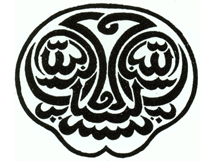
Introduction |

Tiger Motif
Tipu's adoption of the tiger motif as a personal emblem took several
forms. The most obvious examples include the distinctive stylised tiger stripe,
commonly referred to as babri, from babr, (meaning 'tiger'); and the decorative
tiger head. Examples of the babri motif can still be seen on the inner walls of the Gumbaz
mausoleum where there is a complete adornment of the yellow walls with red stripes.
In this case, the monogram of Tipu is the calligraphic merging of the two words Bismillah, and Muhammed. 'Bismillah' is the name of Allah and is derived from the invocatory verse in the Quran: Bismillah-ir-Rahman-nir-Rahim ('In the name of Allah, the Beneficent, the Merciful'); while the name of the Prophet Muhammed is written in the khatt mukabil style of calligraphy. To the untrained eye the words are not readily apparent being overlaid with calligraphic curves, scrolls, decorative lines, ascenders and descenders. The calligraphic tiger motif also includes the epithet asad allah ul-ghalib ('the victorious lion of God'); and examples of its use can be found on a banner of Tipu Sultan, as well as on some of his military arms and armaments.
For further discussion see: Buddle, A. et al. Tigers Round The Throne: The Court of Tipu Sultan. (London: 1990); Brittlebank, K. Tipu Sultan's Search For Legitimacy. (Delhi: 1997) pp.140-146 and Figures 1(a) and 1(b); and Moienuddin, M. Sunset at Sriragapatam: after the death of Tipu Sultan. (London: 2000) pp.140-141. |
|||
|
|
||||
